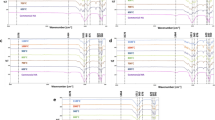Abstract
Hydroxyapatite (HA) can be used as a bioceramic due to its bioactivity and osteoconductive properties. It is clear that the morphology of HA crystal affects on its specifications such as surface and bioactivity. Because of importance of morphology, in the current research nano-sized HA particles were produced using sol–gel and precipitation methods, and to change the morphology, polyethylene glycol (PEG) was used as an organic modifier. The produced samples were characterized using X-ray powder diffraction (XRD) and scanning electron microscopy and transmission electron microscopy. The results of XRD patterns show that the pure HA can be produced using two methods. Microscopic evaluations prove that the presence of PEG has a significant effect on HA morphology. Indeed, PEG changes the morphology of HA produced by precipitation method to irregular, whereas in sol–gel method its shape leads toward fibrous with high aspect ratio. The exact reason of this variation can be attributed to the difference in mechanism of HA growth in two methods.
Graphical Abstract








Similar content being viewed by others
References
Dorozhkin SV (2010) Nanosized and nanocrystalline calcium orthophosphates. Acta Biomater 6:715–734
Kalita SJ, Bhardwaj A, Bhatt HA (2007) Nanocrystalline calcium phosphate ceramics in biomedical engineering. Mater Sci Eng 27:441–449
Eslami H, Solati-Hashjin M, Tahriri M (2009) The comparison of powder characteristics and physicochemical mechanical and biological properties between nanostructure ceramics of hydroxyapatite and fluoridated hydroxyapatite. Mater Sci Eng 29:1387–1398
Wang P, Gong C, Jiang X, Wang K (2010) Effects of synthesis conditions on the morphology of hydroxyapatite nanoparticles produced by wet chemical process. Powder Technol 203:315–321
Moszer N, Salz U (2007) Recent developments of new components for dental adhesives and composites. Macromol Mater Eng 292:245–271
Zhang J, Zhan X, Wen X (2009) Effects of ultrasonic and dispersants on shape and composition of hydroxyapatite by reflux method. Inorg Mater 45:1362–1365
Zhang C, Yang J, Quan Z, Yang P, Li C, Hou Z, Lin J (2009) Hydroxyapatite nano- and microcrystals with multiform morphologies: controllable synthesis and luminescence properties. Cryst Growth Des 9(6):2725–2733
Nayak S, Satpati B (2010) Facile synthesis of nanostructured hydroxyapatite—titania bio-implant scaffolds with different morphologies: their bioactivity and corrosion behavior. J Mater Chem 20:4949–4954
Salarian M, Solati-Hashemian M (2009) Surfactant-assisted synthesis and characterization of hydroxyapatite nanorods under hydrothermal conditions. Mater Sci-Pol 27(4):961–971
Zhang Y (2008) A mild and efficient biomimetic synthesis of rodlike hydroxyapatite particles with a high aspect ratio using polyvinylpyrrolidone as capping agent. Cryst Growth Des 8(7):2101–2107
Alexeev VL, Kelberg EA, Evmenenko GA (2000) Improvement of the mechanical properties of chitosan films by the addition of poly(ethylene oxide). Polym Eng Sci 40:1211–1215
Clavaguera N, Saurina J, Lheritier M (1997) Eutectic mixtures for pharmaceutical applications: a thermodynamic and kinetic study. Thermochim Acta 290:173–180
Zhang S, Gonsalves KE (1997) Preparation and characterization of thermally stable nano hydroxyapatite. J Mater Sci Mater Med 8:25–28
Azzaoui K, Lamhamdi A, Mejdoubi E, Berrabah M, Elidrissi A, Hammouti B, Zaoui S, Yahyaoui R (2013) Synthesis of nanostructured hydroxyapatite in presence of polyethylene glycol 1000. J Chem Pharm Res 5(12):1209–1216
Rogel MR (2006) Effects of hydroxyapatite crystal morphology on osteoblast-like cell response. Ph.D. thesis, University of Notre Dame
Koutsoukos PG, Nancollas GH (1981) The morphology of hydroxyapatite crystals grown in aqueous solution at 37°C. J Cryst Growth 55(2):369–375
Joseph R, McGregor WJ, Martyn MT, Tanner KE, Coates PD (2002) Effect of hydroxyapatite morphology/surface area on the rheology and processability of hydroxyapatite filled polyethylene composites. Biomaterials 23(21):295–302
Sato K, Hotta Y, Nagaoka T, Yasuoka M, Wa-tari K (2006) Agglomeration control of hydroxyapatite nano-crystals grown in phase-separated microenvironments. J Mater Sci 41(17):5424–5428
Brundavanam RK, Jiang ZT, Chapman P, Lê XT, Mondinod N, Fawcett D, Poinem GEJ (2011) Effect of dilute gelatine on the ultrasonic thermally assisted synthesis of nano hydroxyapatite. Ultrason Sonochem 18(3):697–703
Qiu C, Xiao X (2008) Biomimetic synthesis of spherical nano-hydroxyapatite in the presence of polyethylene glycol. Ceram Int 34:1747–1751
Author information
Authors and Affiliations
Corresponding author
Rights and permissions
About this article
Cite this article
Yousefi, K., Zebarjad, S.M. & Vahdati Khaki, J. Comparison of polyethylene glycol effect on hydroxyapatite morphology produced into different methods: sol–gel and precipitation. J Sol-Gel Sci Technol 76, 592–598 (2015). https://doi.org/10.1007/s10971-015-3809-y
Received:
Accepted:
Published:
Issue Date:
DOI: https://doi.org/10.1007/s10971-015-3809-y




